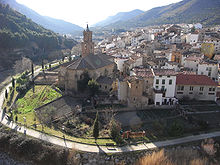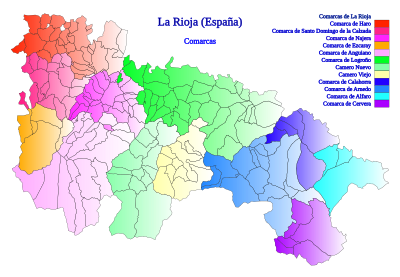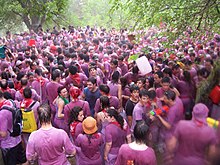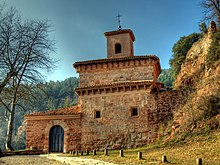La Rioja
This article includes a list of references, related reading, or external links, but its sources remain unclear because it lacks inline citations. (December 2009) |
La Rioja | |
|---|---|
 Autumn in La Rioja | |
 Map of La Rioja in Spain | |
| Capital | Logroño |
| Government | |
| • President | Pedro Sanz Alonso (PP) |
| Area (1.0% of Spain; Ranked 16th) | |
| • Total | 5,045 km2 (1,948 sq mi) |
| Population (2007) | |
| • Total | 308,968 |
| • Density | 61/km2 (160/sq mi) |
| • Pop. rank | 17th |
| • Percent | 0.7% of Spain |
| Demonym | |
| ISO 3166-2 | LO |
| Official languages | Spanish |
| Statute of Autonomy | June 9, 1982 |
| Parliament | Cortes Generales |
| Congress seats | 4 (of 350) |
| Senate seats | 4 (of 264) |
| Website | Gobierno de La Rioja |
La Rioja (English: /lə riːˈoʊhə/; Spanish: [la ˈrjoxa]) is an autonomous community and a province in Spain, located in the north of the Iberian Peninsula. Its capital is Logroño. Other cities and towns in the province include Calahorra, Arnedo, Alfaro, Haro, Santo Domingo de la Calzada, and Nájera. It has an estimated population of 322,415 inhabitants (INE 2010).
It covers part of the Ebro valley towards its north and the Iberian Range in the south. The community is a single province, so there is no County Council and it is organized into 174 municipalities. It borders the Basque Country (province of Álava) to the north, Navarre to the northeast, Aragón to the southeast (province of Zaragoza), and Castilla y León to the west and south (provinces of Burgos and Soria).
The area was formerly occupied by pre-Roman berones, pelendones and Basques. After partial recapture to the Muslims in the early tenth century, the region became part of the Kingdom of Pamplona, later being incorporated into Castile after a century and a half of disputes. From the eighteenth century the Rioja region remained divided between the municipalities of Burgos and Soria, until in 1833 the province of Logroño was created, changing the name of the province to La Rioja in 1980 as a prelude to its constitution under a single provincial autonomous community following the adoption of the Estatuto de San Millán in 1982. The first written reference in which the name Rioja appears is in the Miranda de Ebro forum in 1099.
The region is well known for its wines under the brand Origen Calificada Rioja.
History
In Roman times the territory of La Rioja was inhabited by the tribes of the Berones (central country), Autrigones (upper country, extending also north and west of it) and the Vascones (lower country, extending also north and east of it). It was part of the province of Hispania Tarraconensis.
In Medieval times La Rioja was often a disputed territory. The Visigoths created the Duchy of Cantabria that probably included most of La Rioja, as a border march against the Vascones. The area was invaded by the Muslims at the beginning of the eighth century. After the Muslim invasion of 711, La Rioja fell into the Muslim domains of Al Andalus.
Most of the territory was reconquered in the early 10th century, in 923, by Sancho I of Pamplona, acting for the Kingdom of Pamplona together with the Kingdom of León and the Counts of Castile, feudal lords of the Leonese King. The lower region around Arnedo came under control of his allies the Banu Qasi of Tudela. The territory to the east of the Leza River remained under Muslim control.
Later there was a dispute between the Castilian Count Fernán González and the kings of Pamplona-Navarra, involving great battles. It was decided in favour of the Navarrese after the imprisonment of the Count family in Cirueña, in 960.[1] La Rioja briefly formed the independent Kingdom of Viguera from 970 to about 1005, at which point it became a part of the Kingdom of Pamplona.
Sancho Garcés moved the capital of the Kingdom of Pamplona to Nájera (La Rioja), creating the so-called kingdom of Nájera-Pamplona which was, due to its large size, the first Spanish Empire.
After the independence of Castile in 1035, this new kingdom fiercely fought against Pamplona for the possession of Bureba, La Rioja and other territories. In 1076, after the murder of Sancho VI, Navarre was divided among Castile and Aragon. Castile obtained La Rioja and many other Navarrese lands.[1]
Nevertheless, since 1134, García Ramírez the Restorer and his son Sancho VI the Wise fought bitterly with Castile for the recovery of the former Pamplonese domains. Only in 1179 would they sign a peace agreement by which La Rioja was ceded definitively to Castile.
The territory remained divided between the provinces of Burgos and Soria until the administrative reform of Riego in 1822 that created the province of Logroño.
In 1980 it changed its name to province of La Rioja and in 1982 it was constituted as uni-provincial autonomous community with that name.
Dinosaur footprints

During the Early Cretaceous period the geographical area of Cameros was part of a flooded plain that drained periodically, leaving behind muddy areas where dinosaur tracks marked the path. Eventually they were dried and covered with new sediment layers whose weight pressed down on the lower layers, causing them solidify into rocks over millions of years. Erosion has been wearing down the upper layers making many of these rock formations visible, bringing into view the footprints (footprints fossils). La Rioja is notable for the number and conservation of these sites, making it, according to experts, one of the most important paleontological areas of the world, in addition to those found in the north of Soria, such as Yanguas, Santa Cruz de Yanguas and other highland locations.[2]
Recent history

The territory of La Rioja (the name appeared in a charter of 1099) was formerly known as the province of Logroño for the fortified site around which it developed. The 12th-century church Iglesia de Santa Maria de Palacio recalls its origin as a chapel of the administrative palace. Logroño was a borderland disputed between the kings of Navarre and the kings of Castile starting in the 10th century; the region was awarded to Castile in a judgement by Henry I of England and annexed in 1173 (1177?). Its importance was that here the pilgrimage route to Santiago de Compostela, the Camino de Santiago, crossed the River Ebro on the stone bridge, the Puente de Piedra.

La Rioja was taken by Napoleonic forces in the Peninsular War and remained solidly in French hands until 1814. In the 1810 project of Llorente it was to be a part of the prefecture of Arlanzón (capital in Burgos). The Constitutional Cortes declared La Rioja an independent province at the time of the Liberal Constitution of 1812, and in January 1822 the province of Logroño was created by royal decree, taking in the whole of the historical geography of La Rioja. However, Ferdinand VII soon annulled these decisions and recovered most of the divisions of the Ancien Régime. In the 1833 reorganization, a province of Logroño appeared again in the region of Castilla la Vieja. In 1841, the province increased its territory temporarily.
It was made into an autonomous community during the reorganization following the democratic transition after the death of Francisco Franco, owing to its economic distinction from the surrounding regions. It is the second-smallest autonomous community in Spain and has the smallest population; fully half of its 174 municipalities have populations under 200. Nearly half of its citizens live in the capital.
Geography

La Rioja is bordered by the Basque Country (province of Álava), Navarre, Aragón (province of Zaragoza), and Castile and León (provinces of Soria and Burgos). The river Ebro flows through this region, as does the river Oja, after which it is named.
After the Ebro river flows through the narrow channel between the rocks of the Conchas de Haro, it reaches La Rioja, through which it runs for 120 km, before continuing its journey to the Mediterranean. In the Conchas de Haro the altitude of the river is 445 m and when it leaves the community, in the Sotos del Ebro Natural Reserve in Alfaro, it is 260 m high. The river therefore flows very quickly through La Rioja.

1. Ebro River.
2. Puerto de Piqueras.
3. Conchas de Haro.
4. Iberian Range.
5. Puerto de Oncala.
6. Sierras de Cantabria y Codés. |
11. Leza River Valley. |
The Ebro runs through the north of the community. The entire right bank (which is to the south) belongs to La Rioja. On the left bank there are only three municipalities, Briñas, San Vicente de la Sonsierra and Ábalos (known as the Riojan Sonsierra), although Logroño, Agoncillo, Alcanadre, Rincón de Soto and Alfaro are also part of the municipality's territory on that bank. Because of their proximity, the Álava area between the Ebro and the Sierra de Cantabria is called Rioja Alavesa.
The Iberian mountain range, with altitudes ranging between 1,000 and 2,000 meters, extends parallel to the south of the river for about 60 to 40 km. From the mountain range it moves towards the north, going deep into La Rioja, the Demanda mountains, and in the Monte San Lorenzo where, at 2271 m, it represents the highest altitude in La Rioja.
Seven rivers descend rapidly towards the Ebro from the mountain range, which is why La Rioja is sometimes called: "Zone of the seven valleys". They are, from east to west, Alhama, Cidacos, Leza, Iregua, Najerilla, Oja (river)Oja and Tirón, although the headwaters of the Alhama and Cidacos originate in Soria and those of Najerilla-Neila and Tirón are from Burgos. Sometimes Linares (a tributary of Alhama) is added, grouping Tirón with its tributary, the Oja.
All the rivers of these valleys form tributaries that go on to form as many valleys in their own right, such as those of Linares, Ocon, Jubera, Tuerto, Brieva, Viniegras and San Millán. There is an almost unlimited number of grandiose canyons, quite splendid in nature, such as Aguas Buenas, Nieva, Manzanares, Ardancha, Navajún, Valderresa, Ollora, Tobia, San Martín and others.
In the highlands oaks, beech and pine are grown. There are also thickets of juniper, boxwood, sloes, holly and cistus. There are grand hillsides with fine pasture for livestock, cattle and sheep. In the lower areas there are oaks, olive and almond trees. Near the Ebro, in the plains, the land is used for cereal, sugar beet and potatoes, while the hills are covered with vast vineyards of the wine that has brought worldwide fame to this region.
All Riojan rivers, including the Ebro, have a row of poplars and cottonwood. About the Riojan Alamos Ana Maria Matute has written: "... see them on the edge of the water, turning the landscape, like spears magical pointing towards the unreal and mysterious country of the riverbed."[3]
Mountains and mountain ranges
All Mountains in La Rioja are part of the Iberian System:
- Sierra de la Demanda
- Sierra de Camero Viejo
- Sierra de Camero Nuevo
- Sierra de Cebollera
- Picos de Urbión
- Monte San Lorenzo
- Skit
Comarcas

Geographical comarcas:
Climate
- The climate is mainly Continental climate. The Rioja Alta comarca receives more precipitation than Rioja Baja.
- The average temperature ranges from 11.8°C - 31.8°C (53°F - 88°F) and the precipitation ranges between 300 mm - 600 mm as an annual average.
- The wind called Cierzo is very frequent around La Rioja during the winter.
Hydrography
- Ebro - the most important river that crosses the Community. In La Rioja it has the following affluents:
- Tirón
- Oja

Flora and fauna
Natural resources

Economy
La Rioja is known for its production of Rioja DOCa wines (although the Rioja viticultural region extends slightly into the neighboring administrative regions of Álava and Navarra).
- Agriculture:
- Dryland farming: Wheat, Barley and Grape.
- Irrigation: Asparagus, Capsicum ... others.
- Animal husbandry of sheep

- Rioja (wine)
- Industry:
- Wine production and conserves: in Logroño, Cenicero, Haro and Calahorra.
- Textiles and footwear: in Logroño, Arnedo, Cervera del Río Alhama and Ezcaray.
- Furniture factories: in Ezcaray, Logroño and Nájera.
- Rubber, plastics, chemical products and transport machinery.
- Natural Chorizo,Casalarreina
Main products from La Rioja sold to Spain include:
Exports are directed mostly towards the European Union, United States and Canada.
Transport
- Logroño-Agoncillo Airport
- N-111
- N-232
- N-120
- Autovía A-12
- Autopista AP-68
- Autopista AP-69 (proposed)
- Piqueras Tunnel
- Puerto de Oncala
- Puerto de Piqueras
Demography

According to the INE the population of La Rioja (as at 2010) is 322,415 inhabitants, with 161,884 men and 160,531 women, which is 713 more than in 2009. Its population density is 63.76 people per km2.[4] It is the least populous autonomous community in Spain. Its capital, Logroño, with approximately 152,500 inhabitants, is its most populous city.
La Rioja has 174 municipalities (see List of municipalities in La Rioja). According to the same INE data, there are more men than women in 150 of them, in two the numbers are the same and in 22 there are more females than males. In the latter set, the differences are small, except in the capital where there are 4,868 more women than men.
| Vertical bar chart demographic of La Rioja between 1857 and 2010 |
 |
| Legal population (1857-1897) according to the population census published by the Instituto Nacional de Estadística in the nineteenth century.
Legal population (1900-1991) or Resident population (2001) according to the population census published by the Instituto Nacional de Estadística.
Population according to the municipal register of 2010 published by the Instituto Nacional de Estadística.
|
Major cities

| Rank | City | Population (2011)[5] |
|---|---|---|
| 1 | Logroño | 152,641 |
| 2 | Calahorra | 24,839 |
| 3 | Arnedo | 14,457 |
| 4 | Haro | 11,776 |
| 5 | Alfaro | 9,827 |
| 6 | Nájera | 8,452 |
| 7 | Lardero | 8,438 |
| 8 | Villamediana de Iregua | 6,958 |
| 9 | Santo Domingo de la Calzada | 6,694 |
| 10 | Autol | 4,458 |

Education
According to the 2007 PISA report, education in La Rioja is of the highest quality in Spain, close to that of other European countries with better overall educational levels in terms of student knowledge. In the Ministry of Education's 2009 report La Rioja was in first position among the autonomous communities as it relates to general aspects of primary and secondary education.[6]
It is placed above the Spanish average in the list of communities with the lowest levels of school failure, with 85% of students being able to obtain the ESO title, despite its schools having the highest proportion of enrolled immigrants.[7]
6208 euros are spent per pupil, making it the tenth ranked community in this regard.[6] The majority of educational institutions in the community are public, followed by subsidized and private schools, the latter of which are very scarce at the primary and secondary levels. The bachillerato is free in public schools and at a cost in charter schools.[8]
In La Rioja the portion of the population with higher education is 30.6%, with two institutions offering studies at this level: the University of La Rioja (UR) and the National University of La Rioja (UNIR).
Communication and transportation
La Rioja has connections by air via the Logroño-Agoncillo Airport.
Rail journeys to Madrid, Zaragoza, Barcelona, Valladolid, Oviedo, Bilbao, La Coruna, Vigo are possible, since the Castejón-Miranda line crosses the region from east to west. The main railway station is that at Logroño.
Road communications between La Rioja and neighboring regions are primarily through the AP-68. Additional highways have been built, such as the Autovía A-12 which connects Pamplona to Logroño from 2006, and in the future will reach Burgos.
Government and politics
- Statutes of Autonomy - [1] Template:Es icon
- Presidents - Current President: Pedro Sanz Alonso of Partido Popular.
- Diputación General - Official Website
- Consejo de Gobierno - Official Website
- Tribunal Superior de Justicia - Official Website
Monuments

- Monastery of Santa María la Real of Najera
- San Millán de la Cogolla
- Concatedral de Santa María de la Redonda
- Catedral de Santo Domingo de la Calzada
- Iglesia de Santo Tomás
Native or Famous people from La Rioja
- Gonzalo de Berceo
- Domingo de Silos
- Manuel Bretón de los Herreros
- Gustavo Bueno
- Práxedes Mateo Sagasta
- Fausto Elhuyar
- Juan José Elhuyar
see also Category:Riojan people
Other topics
- University of La Rioja, the autonomous university. Official Website
- Dulzaina, a popular musical instrument from La Rioja.
- Jota (music), a popular dance practiced in some comarcas of La Rioja.
- History of Rioja wine
- Caparrones, one of the most important dishes in Riojan cooking
References
- ^ a b Javier García Turza. La Rioja entre Navarra y Castilla. Del mundo agrario al espacio urbano. Retrieved 12 January 2013.
- ^ "Fósiles de La Rioja permiten reconstruir totalmente el dinosaurio 'Baryonix' (Fossils of La Rioja allow the full reconstruction of the 'Baryonix' dinosaur)" (in Spanish).
- ^ "Guía de La Rioja" (PDF). Retrieved 12 January 2013.
- ^ "Datos de población por municipios del INE (INE population data by municipalities)" (in Spanish).
- ^ "Nomenclátor INE".
- ^ a b V. Soto (21 April 2010). "La Rioja mantiene la mejor educación de España tras la evaluación de diagnóstico del Ministerio" (in Spanish). Logroño. Retrieved 11 January 2013.
- ^ Juan Antonio Gómez Trinidad (1 February 2006). "El fracaso escolar en La Rioja es del 15%" (in Spanish). Retrieved 11 January 2013.
- ^ Valeriano Sarto Fraj (21 September 2009). "El concierto de Bachillerato para no segregar" (in Spanish). Retrieved 11 January 2013.
See also
External links
- Government of La Rioja Template:Es icon
- "A Brief History of La Rioja"
- Dinastia Vivanco Museum of the Culture of Wine
- Page on the City of Calahorra Template:Es icon
- Official page
- La Tierra con Nombre de Vino - page on La Rioja Template:Es icon
- Popular Culture in La Rioja Template:Es icon
- Manuel Alvar, El dialecto riojano (The Riojan dialect), Madrid, Editorial Gredos, Biblioteca Románica hispánica, 1976, 200 pages. Template:Es icon
- Dictionary of 'Riojan'ismsTemplate:Es icon


